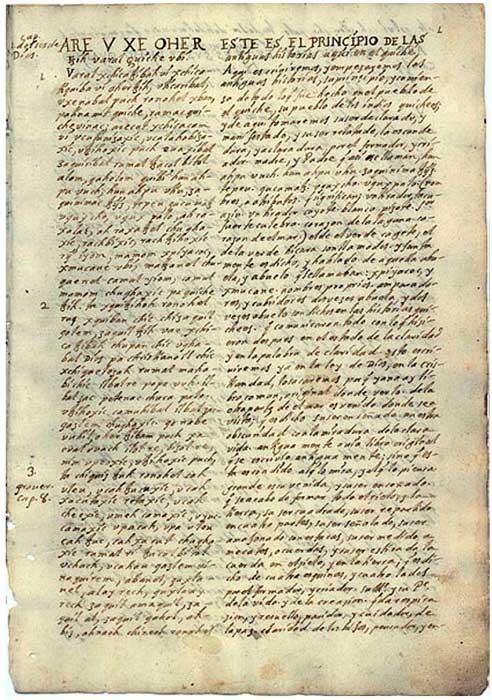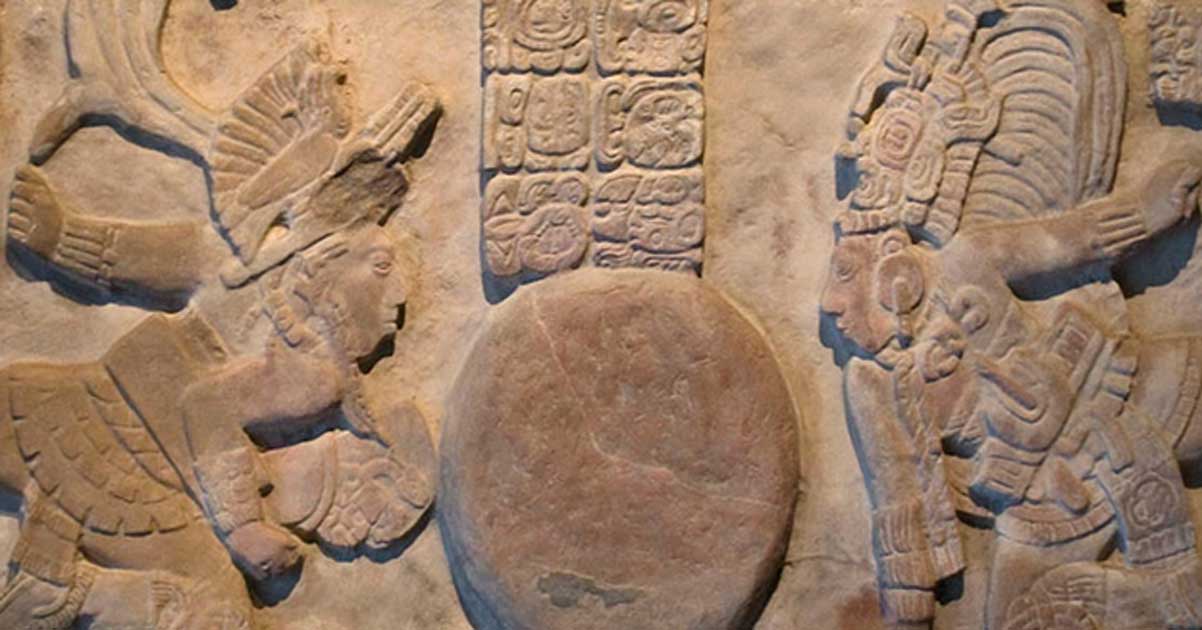2,000-Year-Old Carving and 16th Century Manuscript Reveal Some Maya Came from Across the Sea
The Popol Vuh, a corpus of mythological and historical narratives according to the Quiché-Maya people, and Izapa Stela 5, a carved stela found at the ancient Mesoamerican site of Izapa in Mexico, provide a fascinating insight into Mexican history. In fact, together, they may reveal that some of the ancestors of the Quiché-Maya came from across the sea.
Popol Vuh Reveals Foreign Origins
In the English translation of the Popol Vuh, it reads: “We shall write about this now amid the preaching of God, in Christendom now. We shall bring it out because there is no longer a place to see it, a Council Book, a place to see “The Light That Came from Beside the Sea”, the account of “Our Place in the Shadows”, a place to see “The Dawn of Life” …… (Tedlock, 1992, p.63).
The Popol Vuh refers to their ancestors coming from the East, which is a significant statement. East of the Maya would be the Gulf Region.
The Popol Vuh continues: “They didn’t know where they were going. They did this for a long time, when they were there in the grasslands: the black people, the white people, people of many faces, people of many languages, uncertain there at the edge of the sky” (Tedlock, 1992, pp.149-150).

An 18th century translation of the Popol Vuh. (Public Domain)
Izapa Stela 5 is Consistent with the Popol Vuh
Izapa-style art is characterized by upright stone stelae found at the site of Izapa, situated near Tapachula, Chiapas. Izapa is located on the Pacific coastal plain in an area known as Soconusco.
The Izapa stela no.5 is one of many carved stelae found at Izapa which date from roughly 300 BC to 50 BC. This monument has interesting iconographic representations that support some of the migration stories handed down from generation to generation by the Mexicans.
- Popol Vuh: The Sacred Narrative of Maya Creation
- Researchers confirm that recently discovered Tonina Pyramid is Largest Pyramid in Mexico
- Unravelling the Mysteries of the Tomb of the Red Queen of Palenque

Night photography of stela 5 at Izapa ruins, Tapachula, Mexico. (CC by SA 3.0)
The research of the New World Archaeological Foundation indicates that this site has been continuously occupied since 1500 BC. Much of what we know about the art from Izapa comes from the work of Virginia Smith's Izapa Relief Carving (1984), Garth Norman's Izapa Sculpture (1976) and Jacinto Quirarte's Izapan-Style Art (1973). Garth Norman of the New World Archaeological Foundation has published many of the stone stelae and altars found at Izapa and has discussed much of their probable religious significance.
Symbology of Stela 5
The stela no.5 records many glyphic elements common to other pre-classic artifacts including the jaguar, falling water, mountain, bird, dragon tree, serpent, and fish motifs. This stela also provides many elements that relate to Mexican and Maya traditions, as accurately analyzed by Norman (pages 165-236). Some ideological factors not fully discussed in regards to this stela are elements linked to the Olmec religion and the migration traditions of the Mexicans.
Ancient Migration Stories of Mexico
The Maya were not the first to occupy the Yucatan and Gulf regions of Mexico. It is evident from Maya traditions and the artifacts recovered from many ancient Mexican sites that a different race lived in the area before the Mayan speakers settled this region. The linguistic evidence suggests that a new linguistic group arrived in the Gulf region of Mexico at around 1200 BC.
M. Swadesh (1953) has presented evidence that at least 3,200 years ago, a non-Maya speaking group wedged itself between the Huastecs and the Maya.

Ruins at Izapa, Chiapas, Mexico. (Eduardo Robles Pacheco / flickr)
Traditions mentioned by Bernardino Sahagun, a missionary priest who participated in the Catholic evangelization of Mexico, record Mexico’s settlement story. Sahagun says that these "Eastern settlers of Mexico landed at Panotha, on the Mexican Gulf. Here they remained for a time until they moved south in search of mountains”.
Friar Diego de Landa, in Yucatan Before and After the Conquest, wrote that "some old men of Yucatan say that they have heard from their ancestors that this country was peopled by a certain race who came from the East, whom God delivered by opening for them twelve roads through the sea" (p.28).
This tradition is most interesting because it probably refers to the twelve migrations to Mexico. This view is also supported by Stela 5 from Izapa. In Izapa Stela 5 we see a group of men on a boat riding the waves.

An illustration of Izapa Stela 5. (CC by SA 3.0)
It is clear that Stela No.5 is not only symbolic of the tree of life, it also supports the traditional accounts recorded by Friar Diego de Landa that people made twelve migrations to the New World. In the center of the boat on Stela No.5, we find a large tree. This tree has seven branches and twelve roots. The seven branches probably represent the seven major clans of the immigrants, while the twelve roots of the tree extending into the water from the boat probably signify the "twelve roads through the sea", mentioned by Friar Diego Landa.
This stela also supports the tradition recorded by the famous Maya historian Ixtlixochitl, that some people came to Mexico in "ships of barks " and landed at Potonchán, which they commenced to populate.
The Mexican migration accounts and the depictions on Izapa stela 5, probably relate to a segment of the ancient Mexicans who landed in boats in Panotha or Pantla (the Huasteca) and moved along the coast as far as Guatemala. This would correspond to the non-Maya speaking group detected by Morris Swadesh that separated the Maya and Huasteca speakers 2000 years ago.
Top image: The Third creation of the Universe by Toniná Divine Lords, Garra of Jaguar (left) amd Kinich Baknal Chaal (right). National Museum of Anthropology, Mexico City. (CC BY SA 4.0)
References:
Friar Diego de Landa, Yucatan Before and After the Conquest. Translated by William Gates (1937), http://store.doverpublications.com/0486236226.html
Garth Norman, Izapa Sculpture, 1976.
Jacinto Quorate, Izapan -Style Art, 1973.
Virginia Smith, Izapa Relief Carving, Studies in Pre-Columbian Art and Archaeology, No. 27, 1984.
Morris Swadesh. The Language of the Archaeological Haustecs. 1953.
Clyde Winters, Atlantis in Mexico: The Mande Discovery of America. https://www.amazon.com/Atlantis-Mexico-Mande-Discovery-America/dp/0615803636/
Clyde Winters, African Empires in Ancient America. https://www.amazon.com/African-Empires-Ancient-America-Winters/dp/0615796583/


















Comments
Wow! What a great group of dialogues-Thanks! My Comment is from history I've read of the Cherokee people who are a part of my 'mixology'. Their Origin Story has it the they 'were from the land where the sun also rises'; the East-also. Other Eastern tribes in this continent, the Iroquois as I recall, referred to them as ' The People Who Live In Caves ' , so perhaps this came after they appeared here & had no claimed territory, but this last is only my conjecture. I would think new people would make use of whatever defensible shelter they could get. Also, I contribute the Cherokee's story to add a possibly wider view of this continents' peoples & wonder what could have spurred the many peoples to come here, & does anyone have anything that could show a tie-in to where they, or any, started from? A tall request I'm aware, but am appreciative of a 'Pointing Finger' as what source(s) might show a starting point, alliances that might have helped contribute to a 'mass endeavor'. Thanks in advance, it's an honor to converse in this scholarly company. MMc
True, many Native Americans have curly hair. False, Sumerian colony in South America. The cocaine mummies as well as tobacco residue and silk thread simply prove that goods were traded over vast distances from culture to culture. There is ample proof of trade routes between East Asia and the Americas and Chinese coins that predate Columbus are not uncommon in west coast digs. This does not mean that the Chinese made regular rips to the Americas (though that is a possibility). It simply means that goods changed hands and moves along trade routes that bridged the north Pacific region.
The Cocaine mummies and the Sumerian colony of Kuga-Ki in South America make it clear that Middle Eastern people were probably in Mexico in ancient times; but the appearence of curly hair Meso-Americans may not denote non-Native Americans because the Maya called the Aztecs xilaan “curly or frizzy haired”. Since the Aztec were “curly haired’, there is no reason to believe the Kuno priest on Stela No.5 was not Native American.
It also appears that his sash may be more of arabic style and different from the elaborate belts the others wear and it also appears he has long Curly locks.
Curly Hair+Beard+Turban+Different than traditional style Sash = Not Meso-American in origin?
You are correct, the Kuno priest wears a turban at the base of his conical hat. The turban was a regular feature for some Meso-American elites when they wore conical hats, The student being instructed in the mysteries of the Kuno cult, by the bearded priest wore just a conical hat.
Pages